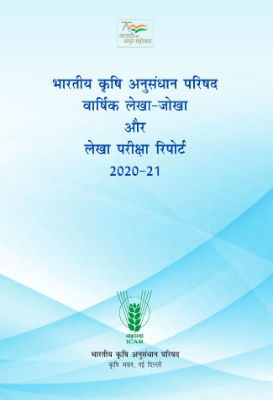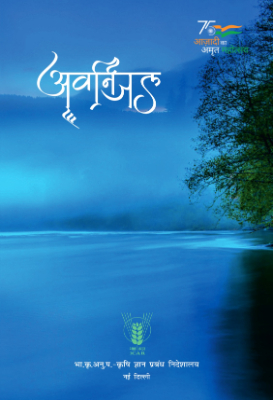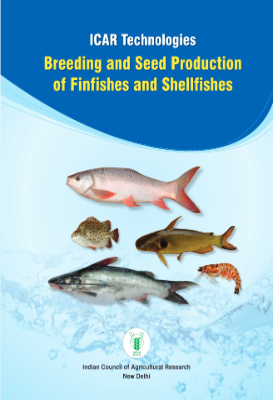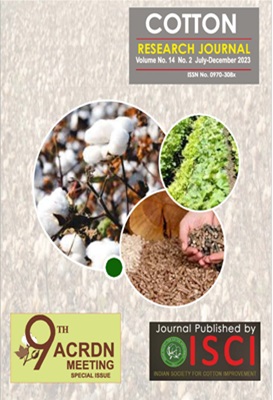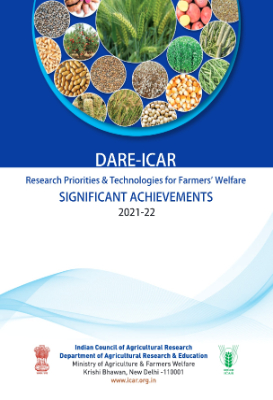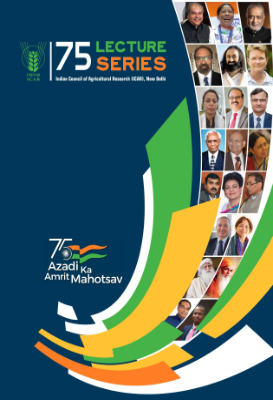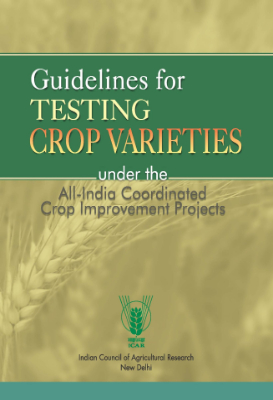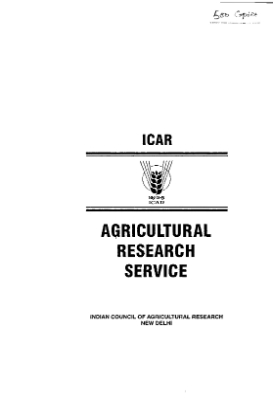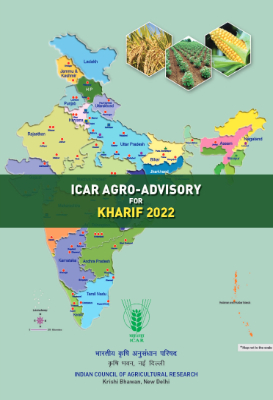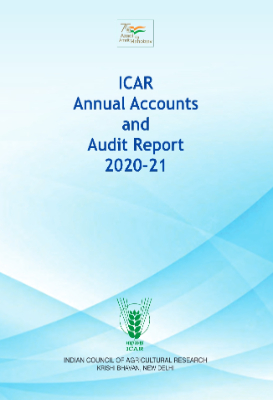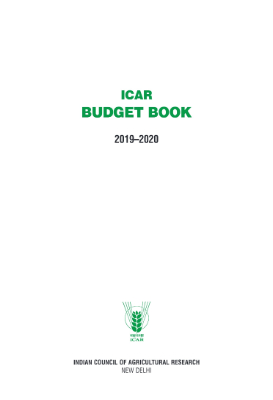E-Resources
Annals of Agricultural Ressearch
The Indian Society of Agricultural Science was established in 1979. The Society is an umbrella society which provides an opportunity to agricultural scientists belonging different disciplines to address the problems confronting Indian agriculture in a concerted and integrated manner. The name of the Society shall be "THE INDIAN SOCIETY OF AGRICULTURAL SCIENCE (ISAS)". The head office of the Society shall be at the Indian Agricultural Research Institute, New Delhi-I 10 012.
AZADI Ka Amrut Mahotsav Commemoration of 75th year of India?s Independence Programmes & Activities
The post-Independence journey of Indian Agriculture has been quite
impressive despite several limiting factors such as uncertainties of weather,
declining soil health, increasing atmospheric temperature and emergence
of more virulent pests and pathogens. The production of food grains, fruits,
vegetables, milk, meat, egg and fish has increased significantly. Systematic
and strategic research has led to development of new technologies to address
specific needs of the farmers. These are being disseminated through the
network institutions in the National Agricultural Research Education and
Extension System (NAREES), regular interaction with state governments
and other stakeholders, and increased use of digital platforms for
communication. Still there exist gaps in transfer of technology/ information
from lab to land. There is a need to strengthen our communication amongst
all stakeholders. The 75th Year of Nation's independence is being celebrated
as Azadi Ka Amrut Mahotsav. The DARE/ICAR has planned various activities
to be undertaken for 75 weeks preceding 15th August 2022. These include
awareness campaigns and lectures by eminent persons on the thematic
areas for reaching out to maximum stakeholders particularly farmers on
various new developments in different sectors of agriculture. This journey
of 75 weeks shall culminate with congregation of farmers who have been
successful in doubling their income, students and academicians with
release of the compendium on farmer's success stories. It is also proposed
to bring out a book on "Indian Agriculture: A Saga of Success-Role of ICAR
through Different Revolutions" and get it released during the occasion.
The proposed activities and campaigns during the 75 weeks of "Azadi ka
Amrut Mahotsav" have been compiled to provide a glimpse of our efforts.
I hope it would be interesting and informative to all the stakeholders.
The feedbacks and suggestions to strengthen our activities in future are
welcome.
Biofortified Varieties: Sustainable Way to Alleviate Malnutrition Third Edition
Nutrition plays central role in growth and development of healthy mind and body. We are
committed to providing a better and sustainable future for all the citizens through nutrition
and food security. Our aim is to ensure healthy lives and promote well-being of people of all ages
through nutritious food. It has been estimated that alleviating malnutrition is one of the most
cost-effective measures, with every $1 invested in proven nutrition programme offering benefits
worth $16.
ICAR has developed 87 biofortified cultivars in 16 crops that can be integrated into the food
chain to enable better health of human and animal populations. Of these, 48 cultivars are multinutrient-dense in nature with two or more traits combined in a single genotype. Dedication
of biofortified crop cultivars on October 16, 2020 (World Food Day) and September 28, 2021,
respectively by the Hon?ble Prime Minister to the nation is a testimony to the commitment
of the country and of the Indian Council of Agricultural Research (ICAR) towards fulfilling
country?s food and nutrition security. This bulletin entitled, ?Biofortified Varieties: Sustainable
Way to Alleviate Malnutrition? highlights the yield potential along with respective nutritional
characteristics of the varieties for propagation and use in the country. I do hope that the
information contained in this bulletin will be of immense use towards building a malnutrition
free India.
Cotton Research Journal
One of the early actions of ISCI has been the launching of a research journal to fill the vacuum created by the stoppage of predecessors like (a) the Indian Cotton Growing Review published by the Imperial Cotton Growing Corporation of UK and (b) the Indian Cotton Development Journal published by the Directorate of Cotton Development. For many decades, these journals had remained as vehicles for research findings on cotton production technologies in India. By 1970 both these journals ceased to appear. The inaugural issue of the ISCI Journal was published in January 1976, since then the periodical has witnessed increasing patronage from cotton scientists from all over India and abroad. By 1990s, the 6- monthly journal had transformed into a quarterly publication to accommodate the rising number of articles originating from ICAR institutes and agricultural universities in which government funded research programmes were on the increase.
Crop Cultivars Developed Through Molecular Breeding
I
ndian Council of Agricultural Research (ICAR) from its inception has spearheaded country?s
preparedness towards feeding the ever-increasing population. The development of improved
high yielding varieties during 1960s made significant increase on food production through
?Green Revolution?. So far, 5800 cultivars of different field crops have been released for cultivation
in various agro-ecosystems of the country. However, development of cultivars takes quite
long time, which generally takes 10-12 years. Taking the help of modern tools, scientists have
been able to curtail the breeding cycle to develop cultivars much faster. ?Molecular Breeding?
technology provides significant advantage over ?traditional breeding? methods, where (i) the
target gene is selected with more precision, (ii) desirable plants are selected at the seedling stage
much before expression of the trait(s), (iii) costly and cumbersome phenotyping during the
breeding programme is bypassed, and (iv) breeding cycle is significantly shortened to 5-6 years.
Using ?Molecular Breeding?, 74 varieties in seven crops namely, rice, wheat, maize, pearl millet,
chickpea, soybean and groundnut have been released for commercial cultivation in India.
It includes, 43 in rice, five in wheat, six in chickpea, six in soybean, two in groundnut, 10 in
maize and two in pearl millet with improved biotic stress resistance, abiotic stress tolerance and
nutritional quality.
This bulletin entitled, ?Crop Cultivars Developed Through Molecular Breeding (second edition)?
highlights the salient features of the varieties and hybrids developed through accelerated
breeding. I dedicate this information bulletin to all our farmers with a hope that these varieties
will reduce the risk due to climate change and enhance their income.
DARE-ICAR Achievements 2021-22
The strong collaboration of ICAR with other stakeholders at grassroots
level continued backstopping towards nation?s food and nutritional security
despite of challenges such as biotic and abiotic stresses in agriculture and
Covid pandemic. The major accomplishments of ICAR during 2021-22 are
precisely presented in this document.
The achievements are grouped into different themes. The release of 389
crop varieties, production of quality breeder seed and planting materials
and promotion of agricultural exports marked the impact of ICAR
technologies. While, the release of biofortified crop varieties, strengthening
POSHAN Abhiyan, promoting startups and entrepreneurs in food processing
especially in millets contributed significantly in enhancement of nutritional
outcome. The climate resilience in agriculture was addressed by releasing
resilient varieties, capacity building in new resilient villages, and revalidating
agriculture contingency plans of 15 districts. In addition, chemical free
agriculture, water footprint reduction, disruptive innovations for smart/precision agriculture summarizes R&D efforts for enhancing respective
resource use efficiencies at field level.
The major achievements in animal productivity and health management
were documentation of indigenous animal breeds, cloning technology
in breeding, feed supplement formulations, dairy technology, and Serosurveillance of animal diseases. The research breakthrough in aquatic
sector is summarized in Blue Revolution. The innovations in farm and postharvest equipments, processing protocols, and storage are covered under mechanization and reduction of post-harvest losses.
During the period, the agricultural education was strengthened through
revision of UG and PG course curricula, quality assurance in higher agricultural
education and enhancement in number and amount of scholarships. Further,
approval of road map for the implementation of New Education Policy 2020
and constitution of a committee for developing syllabus and curricula on
natural farming were the efforts to align agricultural education with National
Educational Policy.
The Lab to Land outreach by KVKs helped ICAR to reach the unreached
through establishment of new KVKs, conduct of FLDs, skill development
trainings, extension activities, and supply of large quality of seeds and
planting materials. Besides, documented ~71000 success stories of farmers
towards Doubling of farmers? income. Effective use of ICT in decision making
and marketing of farm produce for empowering farmers is summarised
under digital linkage with farmers.
The document is an effort to provide a glimpse of ICAR?s R&D achievements
during year 2021-22 under the guidance and supervision of Dr. T. Mohapatra,
former Secretary, DARE and DG,ICAR and support of Dr. Himanshu Pathak,
Secretary, DARE and DG, ICAR. The inputs from all the SMDs/Units are duly
acknowledged with thanks to all the DDGs/ADGs and concerned personnel.
The support of Mrs Suman Khurana, Senior Technical Officer of PIM section
is highly appreciated.
Ex-Situ Crop Residue Management
THE Committee on economic analysis of alternative/ex-situ options of
crop residue management likes to express its sincere and whole hearted
thanks to Dr. Trilochan Mohapatra, Secretary, DARE and DG, ICAR for his
foresight in formulating concepts and ideas for ex-situ management of crop
residues, for instituting this Committee and further for providing his
valuable inputs at various stages for finalizing the "Ex-situ Crop Residue
Management Options" document.
The Committee also extends its sincere thanks to the AS (DARE) and
Secretary (ICAR), Secretary, Ministry of Power, and Secretary, Ministry of
Petroleum and Natural Gas and Director, ICAR-NIAP for valuable guidance
all through for drafting the recommendations.
Thanks are also due to all the members of the High Level Monitoring
Committee on In-situ Crop residue Management Central Sector Scheme,
Director ICAR-CIAE, Bhopal, Dr. KC Pandey, Project Coordinator of AICRP on
Energy in Agriculture and Agro Industries, Dr. Nalini Ranjan Kumar, Principal
Scientist, ICAR-NIAP, Dr. S.S. Sooch, Principal Scientist (Renewable Energy
Engineering), PAU, Ludhiana, Dr Mukesh Jain, Assistant Professor (FMPE),
CSHAU, Hissar, Dr. Panna Lal Singh, Principal Scientist, Agricultural
Engineering Division, ICAR for their outstanding support and cooperation
during the process of discussions and in finalizing the recommendations.
Member Secretary of this Committee Dr. Kanchan Kumar Singh, Assistant
Director General (Farm Engineering) is appreciated, by the rest of the
Committee, for his strenuous efforts in collating the information and drawing
a conceptual framework that formed the basis of our discussions and for the
overall coordination in formulation and finalization of the recommendations.
ICAR Budget Book 2021-22
The Indian Council of Agricultural Research (ICAR) is an autonomous organization at the national level
responsible for the organization and management of research, education and extension in the field of agriculture,
animal sciences and fisheries. The ICAR operates national research and training network consisting of a
number of diversified institutions, viz. Central Research Institutes (CRIs), National Research Centers (NRCs),
Project Directorates (PDs), Project Coordinating Units (PCUs), etc. The ICAR has, thus, been instrumental in
the establishment of innovative institutions for higher education, research and extension training. It has provided
not only developmental assistance and technical guidance but has helped in developing appropriate institutional
models and research strategies.
In the furtherance of its objectives, the ICAR receives budgetary support from the Government under the
bye-laws of the ICAR, by way of :-
(i) Government of India grants;
(ii) Other sources (Internal Resource Generation)
ICAR has fully implemented the Treasury Single Account system with effect from 1st August, 2020. Due
to merger of Plan & Non-Plan Budget from the year 2017-18, the Government?s classification will be done on
Revenue and Capital. The total expenditure to be met out of the Government of India grants has been divided
in three components under Grant for Creation of Capital Assets, Grant-in-Aid-Salary & Grant-in-Aid General
including Pension in respect of various subject matter division, which are further divided into components i.e.
Other than NEH, TSP, SCSP, NEH, TSP and SCSP.
The Budget Book of ICAR comprises of information on summary of Government grant, revenue receipts and
targets, division wise and unit-wise allocation i.e Budget estimates, revised estimates and Actual expenditure
(Part I-VI).
Part-VII gives summary of the cadre strength of Scientists and other categories.



